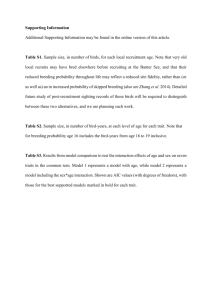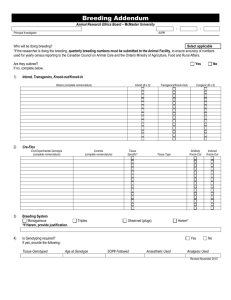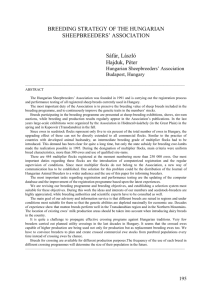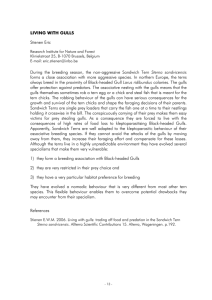Final Exam study guide - People Server at UNCW
advertisement
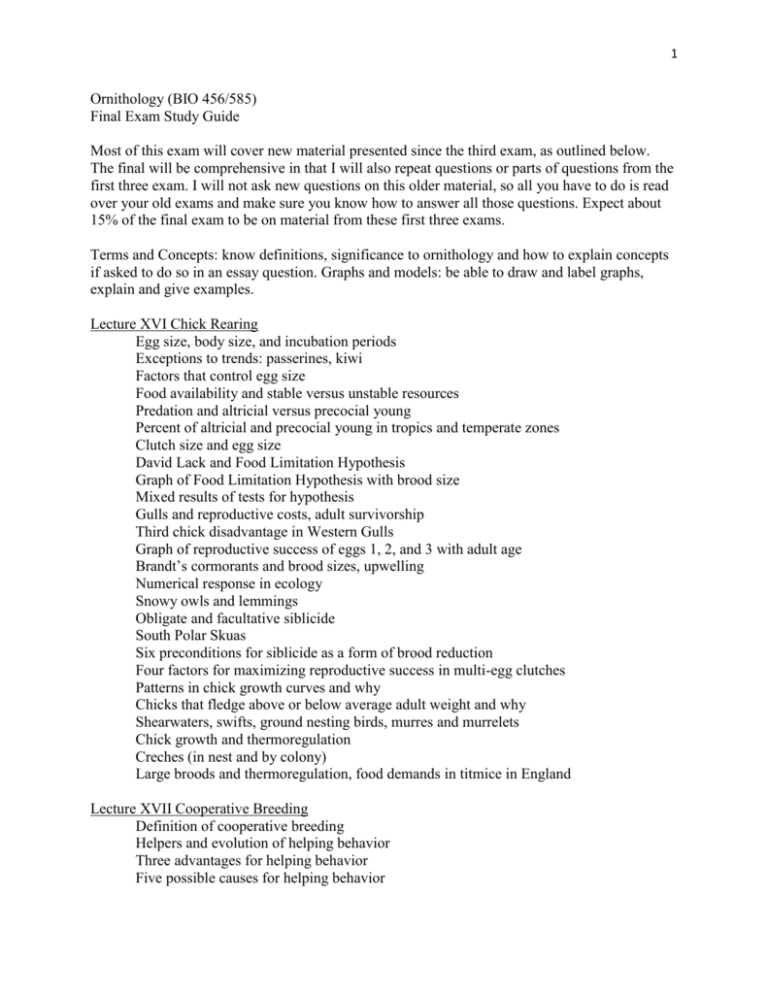
1 Ornithology (BIO 456/585) Final Exam Study Guide Most of this exam will cover new material presented since the third exam, as outlined below. The final will be comprehensive in that I will also repeat questions or parts of questions from the first three exam. I will not ask new questions on this older material, so all you have to do is read over your old exams and make sure you know how to answer all those questions. Expect about 15% of the final exam to be on material from these first three exams. Terms and Concepts: know definitions, significance to ornithology and how to explain concepts if asked to do so in an essay question. Graphs and models: be able to draw and label graphs, explain and give examples. Lecture XVI Chick Rearing Egg size, body size, and incubation periods Exceptions to trends: passerines, kiwi Factors that control egg size Food availability and stable versus unstable resources Predation and altricial versus precocial young Percent of altricial and precocial young in tropics and temperate zones Clutch size and egg size David Lack and Food Limitation Hypothesis Graph of Food Limitation Hypothesis with brood size Mixed results of tests for hypothesis Gulls and reproductive costs, adult survivorship Third chick disadvantage in Western Gulls Graph of reproductive success of eggs 1, 2, and 3 with adult age Brandt’s cormorants and brood sizes, upwelling Numerical response in ecology Snowy owls and lemmings Obligate and facultative siblicide South Polar Skuas Six preconditions for siblicide as a form of brood reduction Four factors for maximizing reproductive success in multi-egg clutches Patterns in chick growth curves and why Chicks that fledge above or below average adult weight and why Shearwaters, swifts, ground nesting birds, murres and murrelets Chick growth and thermoregulation Creches (in nest and by colony) Large broods and thermoregulation, food demands in titmice in England Lecture XVII Cooperative Breeding Definition of cooperative breeding Helpers and evolution of helping behavior Three advantages for helping behavior Five possible causes for helping behavior 2 Non-adaptive hormonal stimulation Inclusive fitness Risk of dispersal Experience at breeding, raising young Access to mates Examples of long-term studies of cooperative breeding systems Acorn Woodpeckers and Walt Koenig Clans and clan sizes Breeding pairs, activities by clan members Pygmy nuthatches and threesomes Advantages to helpers Mobbing, access to winter roost cavities Florid scrub-jay and Glen Woolfenden Scrub/oak/palmetto habitat and evolution of helping Fossil record of scrub-jays in Florida and coastal scrub habitat Delayed breeding, male versus female helpers Helping for one year of two or more years, survival, reproductive success WIMPS Lecture XVIII Social Behavior Definition of social behavior Feeding flocks, intra and interspecific Graph of optimal flock size with time budgets for scanning, feeding, fighting Mixed feeding flocks and advantages Feeding guild and vultures in Africa Roosting flocks and four advantages Predator avoidance, thermoregulation Information exchange, pair bonds Pygmy nuthatch winter roosts Gull clubs and function Konrad Lorenz and Niko Tinbergen Foundations for behavioral ecology Fixed action patterns Learned versus innate behavior Greylag geese and fixed action patterns Behavior in terms of causation, ontongeny, adaptation, and phylogeny Internal and external factors in causation Double-scratch foraging in New World sparrows Winter attendance of territories in gulls, murres Habituation Behaviors as phylogenetic characters Courtship displays, urohydrosis Learned behavior in titmice and milk bottles Methods for studying behavior Quantifying behaviors Penguin predation study 3 Lecture XIX Avian Conservation Contributions of birds studies to biology Five reasons bird studies are important in biology Population and community ecology David Lack, Robert McArthur, Peter Grant Island biogeography Optimal foraging theory Behavioral studies by Konrad Lorenz and Niko Tinbergen Neurobiology and Fernando Nottenbohn Physiological studies Hidden leks Conservation biology, habitat loss Trends in migratory birds in 1970s Rock Creek Park, Washington DC Breeding bird surveys, Xmas bird counts Radar studies of migration, Sidney Gauthreaux Causes for declines, forest fragmentation Tropical deforestation and winter habitat Source/sink areas in ecology IUCN Red Data Books Endangered Species Act 1973 California Condor recovery, use of fossil record Noel Snyder Whooping crane as successful program Dusky seaside sparrow as unsuccessful program Partners in Flight San Pedro River valley, AZ Western Hemisphere Shorebird Reserve Network (WHSRN) Ivory-billed Woodpecker, rediscovery and lost again





